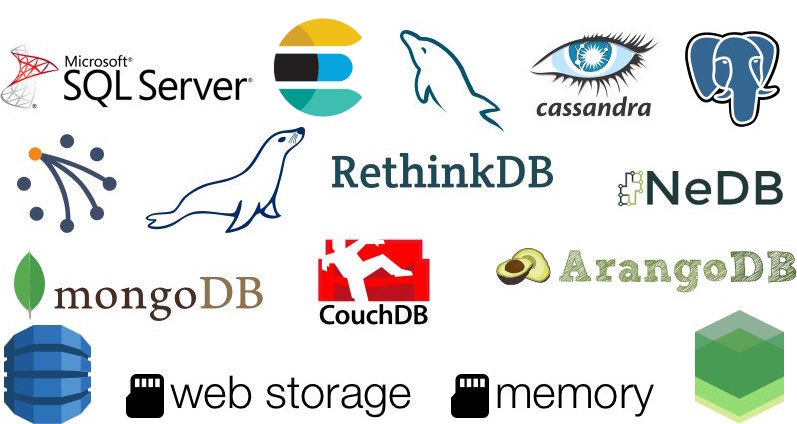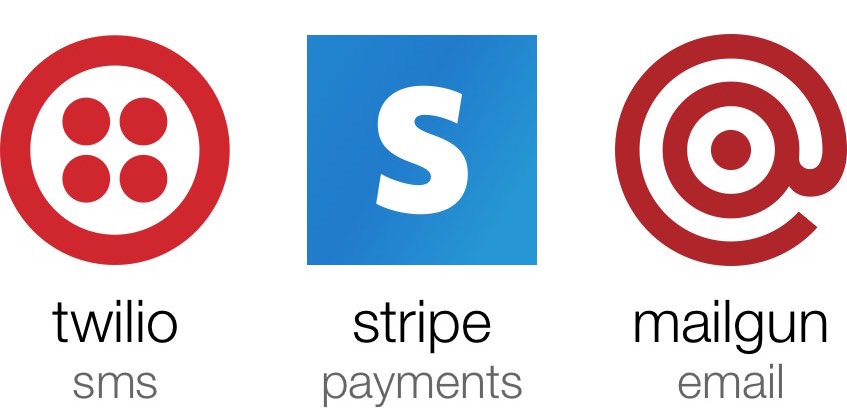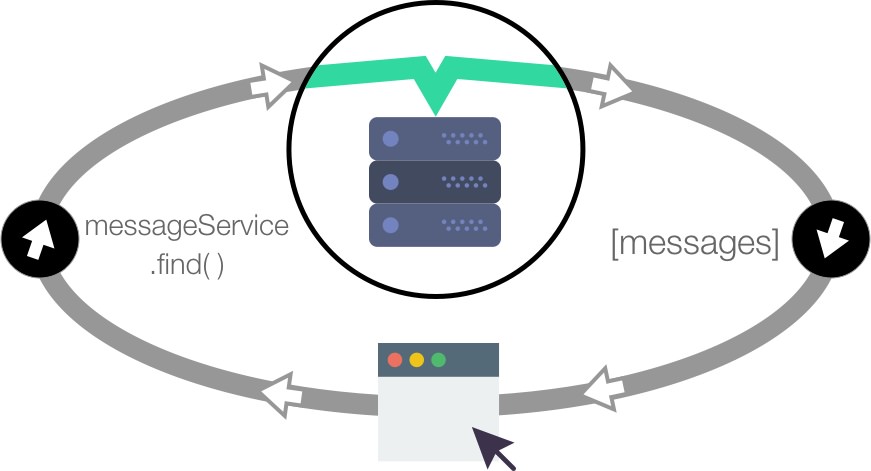
Services
Services are the heart of every Feathers application. They perform the application-level i/o, helping you get data into and out of your app.
A service is simply a JavaScript object that offers one or more of the available service methods:
findgetcreateupdatepatchremovesetup
Services can be used just like an Express middleware:
app.use('/path', serviceObject)
There are three common uses for services:
- Facilitating Data Storage
- Communicating with an External API
- Real-time proxying a legacy server.
Services for Data Storage
The most common use for a service is data storage. Thanks to its simple API and zealous community of developers, Feathers supports more data storage options than any other real-time framework. It also features a familiar query syntax for working with any of the database adapters. (See the section on Databases)

Services for External APIs
Services can also be used to communicate with other API providers. The community has published some great modules:
- feathers-twilio for handling calls and SMS messages over the Twilio API.
- feathers-stripe for processing financial transactions and managing customer data through the Stripe API.
- feathers-mailgun for sending transactional emails over the Mailgun API.

Services that Real-time Proxy a Legacy Server
Services provide an easy path for incrementally upgrading a legacy application to work with a modern API. This is usually done in three steps:
- Logically map service methods to the existing legacy endpoints. This might involve using multiple services.
- Set up each service method to make the request to the legacy API, acting as proxy for the user.
- Update client-side applications to use the Feathers service's endpoints.

A Basic Example
A Feathers application with a very simple service and the REST provider set up can look like this:
// app.js
const feathers = require('feathers');
const rest = require('feathers-rest');
const app = feathers();
app.configure(rest());
app.use('/messages', {
get(id, params) {
return Promise.resolve({
id,
read: false,
text: `Feathers is great!`,
createdAt: new Date().getTime()
});
}
});
app.listen(3030);
After running
$ npm install feathers feathers-rest
$ node app.js
When going to localhost:3030/messages/1 you will see:
{
"id": 1,
"read": false,
"text": "Feathers is great!",
"createdAt": 1458490631911
}
Retrieving services
When registering a service with app.use('/messages', messageService) Feathers makes a shallow copy of that object and adds its own functionality. This means that to use Feathers functionality (like real-time events, hooks etc.) this object has to be used. It can be retrieved using app.service like this:
const messages = app.service('messages');
// also works with leading/trailing slashes
const messages = app.service('/messages/');
// Now we can use it on the server
messages.get(1).then(message => console.log(message.text));

Service methods
Below is a complete example of the Feathers service interface.
const myService = {
find(params [, callback]) {},
get(id, params [, callback]) {},
create(data, params [, callback]) {},
update(id, data, params [, callback]) {},
patch(id, data, params [, callback]) {},
remove(id, params [, callback]) {},
setup(app, path) {}
}
app.use('/my-service', myService);
Or as an ES6 class:
'use strict';
class MyService {
find(params [, callback]) {}
get(id, params [, callback]) {}
create(data, params [, callback]) {}
update(id, data, params [, callback]) {}
patch(id, data, params [, callback]) {}
remove(id, params [, callback]) {}
setup(app, path) {}
}
app.use('/my-service', new MyService());
All of the database adapters are simply wrapper functions. They accept a configuration object and return an implementation of the above service interface. The next two snippets show a simplified example of what it would look like to create and use a database adapter.
/* awesome-db-adapter.js */
// Create an adapter based on the service interface
const awesomeDbAdapter = function (options) {
// Model represents the connection to the datasource.
const Model = options.model;
// Return an object that implements the service interface.
return {
find(params) {
// Do something with the Model, return a promise.
return Model.findAll();
},
get(id, params) {},
create(data, params) {},
update(id, data, params) {},
patch(id, data, params) {},
remove(id, params) {},
setup(app, path) {}
}
}
module.exports = awesomeDbAdapter;
Now here's how it would be used. Remember, it's using a fake awesomeDb package with fake methods for demonstration purposes.
// Bring in the packages for the db and the adapter we just created.
const awesomeDb = require('some-awesome-db-package-from-node');
const awesomeDbAdapter = require('./awesome-db-adapter');
// Initialize the db.
const awesomeDbConnection = awesomeDb({
url: 'https://my-awesome-db-host.com/myDbName'
});
// Pass some options into the adapter. Use the adapter in an API endpoint.
app.use('/my-service', awesomeDbAdapter({
Model: awesomeDbConnection.useThisTableName('awesome-stuff')
});
Since using callbacks is optional, in the above example they've been removed. Keep in mind that services don't have to use databases. You could easily replace the database in the example with a package that uses some API, like pulling in GitHub stars or stock ticker data.
ProTip: Methods are optional, and if a method is not implemented Feathers will automatically emit a
NotImplementederror.
Service methods should return a Promise and have the following parameters:
id- the identifier for the resource. A resource is the data identified by a unique id.data- is the resource data.params- can contain any extra parameters, for example the authenticated user.callback- is an optional callback that can be called instead of returning a Promise. It is a Node-style callback function following thefunction(error, result) {}convention.
ProTip:
params.querycontains the query parameters from the client (see the REST and real-time providers).
These methods basically reflect a CRUD interface:
find(params [, callback])- retrieves a list of all resources from the service. Provider parameters will be passed asparams.query.get(id, params [, callback])- retrieves a single resource with the givenidfrom the service.create(data, params [, callback])- creates a new resource withdata. The method should return a Promise with the newly created data.datamay also be an array which creates and returns a list of resources.update(id, data, params [, callback])- replaces the resource identified byidwithdata. The method should return a Promise with the complete updated resource data.idcan also benullwhen updating multiple records.patch(id, data, params [, callback])- merges the existing data of the resource identified byidwith the newdata.idcan also benullindicating that multiple resources should be patched. The method should return with the complete updated resource data. Implementpatchadditionally toupdateif you want to separate between partial and full updates and support thePATCHHTTP method.remove(id, params [, callback])- removes the resource withid. The method should return a Promise with the removed resource.idcan also benullindicating to delete multiple resources.
Restful Mapping of Feathers Service Methods
| Feathers method | HTTP method | Path |
|---|---|---|
| .find() | GET | /todos |
| .get() | GET | /todos/1 |
| .create() | POST | /todos |
| .update() | PUT | /todos/1 |
| .patch() | PATCH | /todos/1 |
| .remove() | DELETE | /todos/1 |
The setup method
setup(app, path) is a special method that initializes the service, passing an instance of the Feathers application and the path it has been registered on.
For services registered before app.listen is invoked, the setup function of each registered service is called upon invoking app.listen. For services registered after app.listen is invoked, setup is called automatically by Feathers when a service is registered.
setup is a great place to initialize your service with any special configuration or if connecting services that are very tightly coupled (see below), as opposed to using hooks.
// app.js
'use strict';
const feathers = require('feathers');
const rest = require('feathers-rest');
class MessageService {
get(id, params) {
return Promise.resolve({
id,
read: false,
text: `Feathers is great!`,
createdAt: new Date.getTime()
});
}
}
class MyService {
setup(app) {
this.app = app;
}
get(name, params) {
const messages = this.app.service('messages');
return messages.get(1)
.then(message => {
return { name, message };
});
}
}
const app = feathers()
.configure(rest())
.use('/messages', new MessageService())
.use('/my-service', new MyService())
app.listen(3030);
You can see the combined response when going to localhost:3030/my-service/test.
Events
Any registered service will automatically turn into an event emitter that emits events when a resource has changed, that is a create, update, patch or remove service call returned successfully. For more information about events, please follow up in the real-time events chapter.
Protecting Service Methods
There are some times where you may want to use a service method inside your application or allow other servers in your cluster access to a method, but you don't want to expose a service method publicly. We've created a bundled hook that makes this really easy.
const hooks = require('feathers-hooks');
app.service('users').before({
// Users can not be created by external access
create: hooks.disable('external'),
});
Extending or Customizing Services
Services are really easy to create on their own but you can also customize an existing service by extending it in a few different ways. You can learn more by checking out the Extending Database Adapters section.